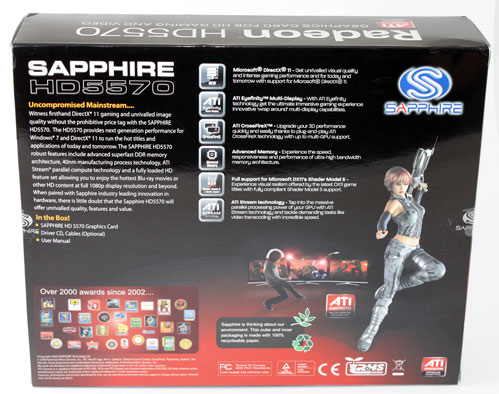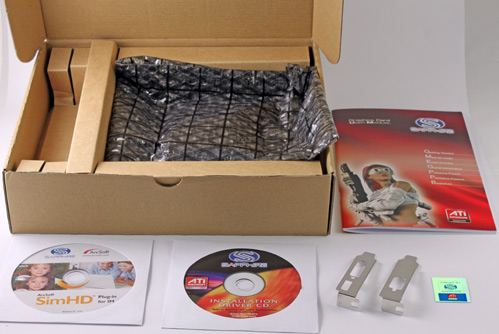Index

Review: Superb performance for HTPCs
This review is also available in German.
Only a few days after launching the Radeon HD 5450, it’s time for HD 5570. Both cards are low end, but the numbering scheme is quick to show that the HD 5570 will be the faster of the two. These two cards belong to the HD 5000 series and are here to nicely fill out the price segments of DirectX 11 graphics market. All the HD 5000 series cards support DirectX 11, ATI Eyefinity technology for multi-monitor setups (more than 2, of course), ATI Stream GPU processing, are built in 40nm, etc.
Radeon HD 5570 is based on the Redwood GPU, one of the GPUs in the Evergreen generation. It’s well worth noting that AMD is the first and, unfortunately for the green team, the only company with DirectX 11, Windows 7 compatible hardware. Starting from the fastest GPU, the Evergreen series features Cypress, Juniper, Redwood and Cedar GPUs.
The HD 5450, which was announced last week, is based on the Cedar GPU and filled out the HD 5000 gap in €40-50 price range, but there’s still a small gap left up to the HD 5670, which is priced at €60-99. So, the new Radeon HD 5570 with its price of €50 will most certainly fit in nicely.
The HD 5570 doesn’t share too many common features with the HD 5670, despite using the same Redwood GPU. The new HD 5570 comes with lower memory and GPU clocks and uses cheaper, DDR3 memory whereas the HD 5670 has GDDR5. Both cards use 128-bit memory interface unlike the HD 5450 which has 64-bit interface.
The HD 5570 is significantly faster than the HD 5450 despite the fact that the price difference is not that big. While the HD 5450’s GPU features only 80 stream processors, 4 ROPs and 8 texture units, the HD 5570’s GPU comes with 400 stream processors, 8 ROPs and 20 texture units, just like on the HD 5670.
The HD 5570’s GPU runs at 650MHz whereas the memory is at 900MHz (1800MHz effectively). Compared to the HD 5670’s 775MHz GPU and 1000MHz memory (effectively 4000MHz), it’s evident that the new HD 5570 is a bit slower.
Lower clocks mean that the HD 5570 consumes less power – 42.7W maximum (HD 5670’s TDP is at 61W). Idle consumption is only 9.69W, and all these numbers show that the card needs no additional power connectors.
Unlike the HD 5670, the new card comes with a low-profile PCB, which is somewhat expected considering the low consumption and low temperatures. A small active but low profile cooler is in charge of cooling.
The HD 5570 comes with three video outs and one of those being DisplayPort means that the card will support ATI Eyefinity technology for three monitors. Of course, there’s also DXVA (DirectX Video Acceleration) support, HDMI 1.3a, Dolby TrueHD, DTS master audio, etc.
The following picture shows the reference HD 5570. Sapphire HD 5570, which our test sample today, runs at reference clocks and is almost identical to the card you see below.

We received the Sapphire HD 5570 1GB DDR3 PCI-E VGA/DVI-I/DP, SKU: 11167-04-40R in a large box that Sapphire uses for HD 5000 series, only this time with another picture. The front shows flagship features like ATI Eyefinity multi-display support, DisplayPort and DVI, DirectX 11 support, ATI Stream, PCI-E 2.0, CrossFireX, LP bracket, 1024MB of DDR3 memory and SimHD plug-in for ArcSoft.

The back of the box is pretty uninteresting; you’ll find some specs listed.

Within the box is another box that keeps the card from potential damage in transport. All the paper used is recyclable.

As is usual with cheaper cards, the card doesn’t come with a free game, but Sapphire conveniently included two low profile I/O panels that can be used instead of the standard panel. The reason is that the original panel might not fit into your HTCP case, and it shows that Sapphire thought it out pretty well. The additional panel with an opening for a VGA connector can be mounted in the free slot next to the card. The VGA connector is connected with a cable so routing it to the next slot is not a problem.
As you can see from the picture, Sapphire HD 5570 1GB DDR3 PCI-E VGA/DVI/DP, SKU: 11167-04-40R is a low profile card but with active cooling. The card is 16.8cm long and is single slot by design. Unlike the passively cooled HD 5450, whose cooler exceeds the width of the card, the HD 5570’s cooling is flush with the PCB and won’t get in the way of equipment above it.

Sapphire HD 5570 card features a Redwood GPU built in 40nm and doesn’t consume much, so there’s no need for external power connectors. The card’s TDP stands at 42.7W whereas minimum consumption in idle mode is at 9.69W.

If you’re worried that Sapphire’s HD 5570 I/O panel is too high and that it might not fit into your mini-ITX or SFF (small form factor) case, it’s time to stop as Sapphire anticipated the issue and ships two additional low profile panels, which you can see below. One of them is for the VGA connector and is placed into a neighboring slot on the case. Naturally, the VGA connector is connected to the card with a cable that will easily reach the graphics card in the next slot.

The cooler has a small fan which isn’t very quiet in 3D, although it’s not too loud either. You’ll hear it in idle mode as well, but it’s nothing that we’d call irritating. Intensive 3D can push the card up to about 75°C, whereas in idle mode temperatures duck to about 37°C. Good thing about this cooling is that the fan can be controlled from ATI’s Catalyst Control Center Overdrive tool.
The I/O panel features dual-link DVI, VGA and DisplayPort outs, meaning the card is capable of ATI Eyefinity support of up to three monitors. If ATI Eyefinity is what you’re looking for, then you’ll have to purchase an HD 5570 card with DisplayPort connector, otherwise you’ll be limited to two monitor setups. Unfortunately, if you don’t have a DisplayPort monitor, you’ll have to purchase an active DisplayPort-to-DVI/VGA/HDMI that’s priced at around €100 (not to be confused with ordinary passive dongles which are cheap and often shipped with cards). Passive converters are much cheaper and will work well but in that case you can forget about Eyefinity.

Sapphire HD 5570 uses 1GB of Samsung’s DDR3 memory (K4W1G1646E-HC12) running at 900MHz (1800MHz effectively). There are four memory modules on each side of the card. The GPU runs at 650MHz.

The following picture shows Sapphire HD 5570 (left) and Sapphire HD 5450 (right). Both cards are low profile with identical set of video outs.

In order to compare Sapphire HD 5570 1GB DDR3’s performance, we used Sapphire HD 5450 512MB DDR3, Radeon HD 5670 1GB GDDR5, Axle GT 240 512MB GDDR5 and Geforce GT 220 1GB GDDR3. All the cards run at reference clocks.
Motherboard: Elitegroup X58B-A (provided by Elitegroup)
Processor: Intel Core i7 Extreme 965 (provided by Intel)
Memory: 6GB Corsair Dominator 12800 7-7-7-24 (provided by Corsair)
HDD: WD VelociRaptor 300G 10k RPM (provided by SmoothCreation)
Power Supply: CoolerMaster Ultimete 1100W (provided by Cooler Master)
Case: Obsidian 800D (provided by Corsair)
Fan Controler: Kaze Master Ace 5.25" (provided by Scythe)
Operating System: Win7 64-bit
Driver: Catalyst 10.1; Forceware 196.34

Futuremark results clearly show how AMD positioned its new DirectX11 card. Its price and performance show that the card is sitting below HD 5670 and above HD 5450.




At 1280x1024, Sapphire HD 5570 scored a playable frame rate in all the games, but it managed even 1680x1050 in some.
Batman - Arkham Asylum
We tested Batman without PhysX effects because the game is unplayable otherwise. Of course, there’s a solution for that and it’s using a Geforce as a dedicated PhysX card. You can find out how to do it and check out the results for yourself here.


Crysis


Dirt 2


Far Cry 2


World in Conflict


Sapphire HD 5570 card runs at 650MHz for the GPU and 900MHz (1800MHz effectively) for the memory. Gaming is possible at reference clocks, but naturally there’s nothing stopping you from overclocking the card and push it even further. We didn’t go further than Catalyst Overdrive allows, which means that you can push the card to 700MHz GPU and 950MHz memory (1900MHz effectively). With this overclock, the card scored 6% in Far Cry 2.
As you can see, the cooler has a small fan, which isn’t very quiet in 3D, although it’s not too loud either. You’ll hear it in idle mode as well, but it’s nothing that we’d call irritating. Intensive 3D can push the card up to about 75°C, whereas in idle mode temperatures duck to about 37°C. Good thing about this cooling is that the fan can be controlled from ATI’s Catalyst Control Center Overdrive tool. After tinkering with settings we made the card run quietly with maximum temperatures at 86°C in 3D mode.

Sapphire HD 5570 comes with low consumption and the card will draw 42.7W at max (HD 5670’s TDP is 61W) whereas idle mode consumption ducks to 9.69W. So, it’s evident that the card doesn’t require additional power connectors.

After introducing the cheapest DirectX 11 card to the market, AMD expanded its offer with yet another HD 5000 series card dubbed the HD 5570. This card should fill the gap between the HD 5450 and HD 5670.
The reason for relatively good performance is 400 stream processors, 8 ROP units and 20 texture units. The same specs are featured on the faster HD 5670, but our today’s card runs at lower clocks. The HD 5570 runs at 650MHz for the GPU whereas the memory runs at 900MHz (1800MHz effectively). Furthermore, the card comes with DDR3 memory which is slower than the HD 5670’s GDDR5, and both cards feature 128-bit memory interface. Note that the currently cheapest DirectX 11 card on the market comes with a 64-bit interface.
Redwood and Cedar based AMD cards, which are currently the HD 5670, HD 5570 and HD 5450 don’t require additional power connectors. The HD 5570 will draw from 9.69W in idle to maximum 42.7W in 3D mode. The small core doesn’t heat up so AMD had no trouble in using a small fan.
Sapphire didn’t change much on the HD 5570. The card is low profile, which will be appealing to those who are looking into the possibility of building an HTPC and the HD 5450 doesn’t quite strike their chord. Sapphire’s I/O panel features a dual-link DVI, DisplayPort and VGA out. The card supports ATI Eyefinity, meaning that you can use three monitors, but such move will require using the DisplayPort as well.
There are many reasons why Sapphire HD 5570 has all the attributes to become your HTPC card – it’s low profile, doesn’t consume much, is HDMI ready, supports Dolby TrueHD and DTS-HD audio bit streaming, features DirectX 11 support, etc. The problem is the price. While AMD announced a price around €55, the cards is now listed for about €70 to €80 which is too close to the HD 5670 which offers much better performance. But we hope, prices will decline.
